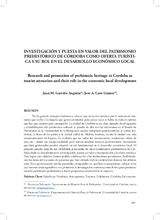Investigación y puesta en valor del patrimonio prehistórico de Córdoba como oferta turística y su rol en el desarrollo económico local
Research and promotion of prehistoric heritage in Cordoba as tourist attraction and their role in the economic local development
Autor
Garrido Anguita, Juan Manuel
Caro Gómez, José Antonio
Editor
UCOPressFecha
2021Materia
PaleolíticoNeolítico
Arte rupestre
Turismo
Prehistoria
Patrimonio
Córdoba (España)
Paleolithic
Neolithic
Rock art
Tourism
Prehistory
Heritage
METS:
Mostrar el registro METSPREMIS:
Mostrar el registro PREMISMetadatos
Mostrar el registro completo del ítemResumen
Por lo general, siempre tendemos a valorar una atracción turística por el número de visitantes que recibe y la riqueza que genera alrededor, pero pocas veces se habla de todo el camino que hay que recorrer para conseguirlo. La ciudad de Córdoba es un claro ejemplo de salvaguarda y rentabilización del patrimonio cultural, y, prueba de ello son las inclusiones en el listado de Patrimonio de la Humanidad de la Mezquita-Catedral (ampliado posteriormente al centro histórico), la fiesta de los patios y la ciudad califal de Medina Azahara, siendo la ciudad con más reconocimientos de España. Es evidente que no todos los monumentos, tradiciones, obras de arte, etc., tienen esa excepcionalidad, pero existen muchos recursos patrimoniales interesantes que bien gestionados pueden adquirir un rol fundamental en el desarrollo económico local. El presente estudio trata de dar visibilidad al recorrido de cinco yacimientos prehistóricos de Córdoba desde su descubrimiento, investigación, puesta en valor e incorporación a la oferta turística. Para lograr este objetivo, hemos pedido colaboración a las instituciones pertinentes, facilitándonos los datos del recuento de personas que han visitado dichos yacimientos durante los últimos años. Esta aproximación nos ha permitido comprender en qué fase se encuentran, valorar si los yacimientos están agotados o no, promover la investigación continua como forma para potenciar nuestro patrimonio prehistórico y hacer propuestas constructivas al respecto. Touristic attractions tend to be valued according to the number and visitors they receive and the economic profit they generate to the area in which they are located. Nonetheless, they difficulties involved in making the attraction appealing and profitable are not reflected about so often. The city of Córdoba is a clear example of protection and promotion of the cultural heritage, as it becomes clear by the monuments included on the World Heritage List, such as the Mosque-Cathedral (later extended to the historic center of the town), the Fiesta of the patios and The Caliphate city of Medina Azahara. As matter of fact, Córdoba is the Spanish city with more monuments awarded recognition by the UNESCO World Heritage List. It goes without saying that not all the monuments, traditions, pieces of art, etc from the city of Cordoba exhibit this exceptionality. Nonetheless, there are still many interesting heritage resources that, well managed, can acquire a fundamental role in the local economic development. The goal of the present paper is to grant visibility to the route of five prehistoric sites in Córdoba, since their discovery, research, promotion and incorporation into the touristic offer. In order to achieve this goal, several different local institutions have collaborated, by providing us with insightful information regarding the number of tourists who have visited the studied sites during recent years. The results of this study are several, since this approach has allowed us to understand their progress, to assess whether the sites are depleted or not, to promote continuous research as a way to enhance our prehistoric heritage and, finally, to make constructive proposals about it.

